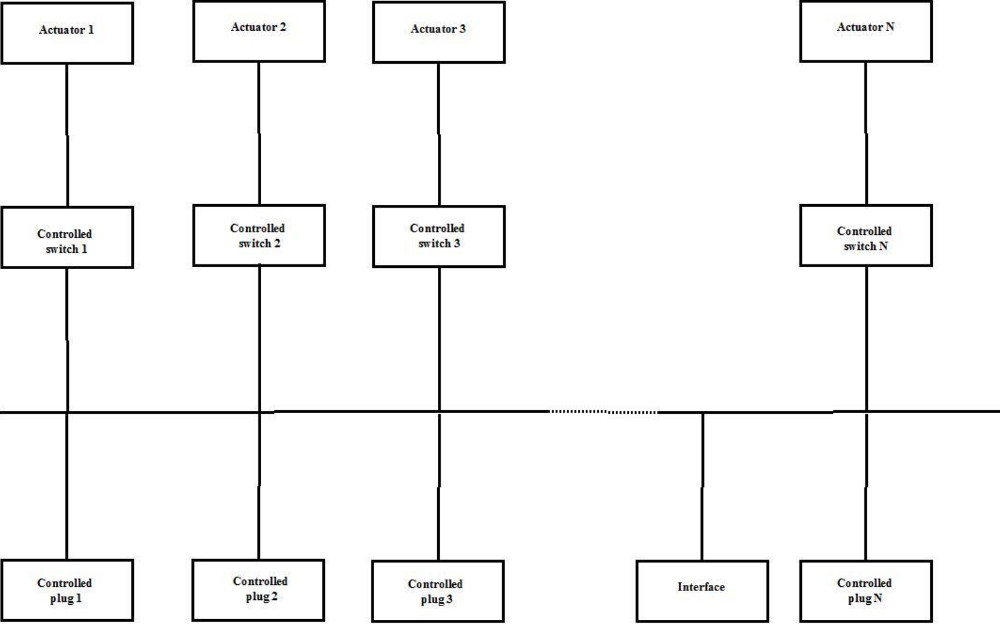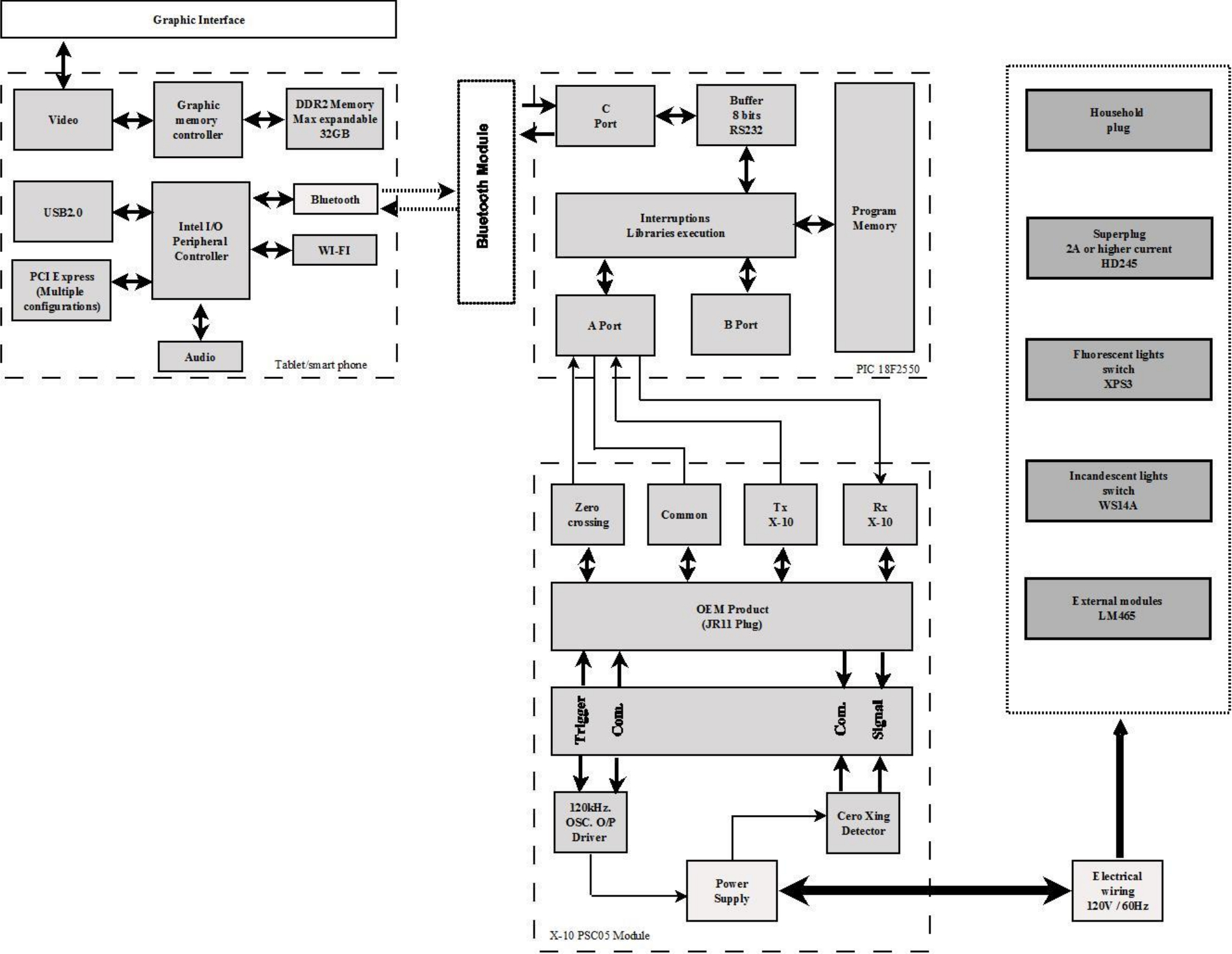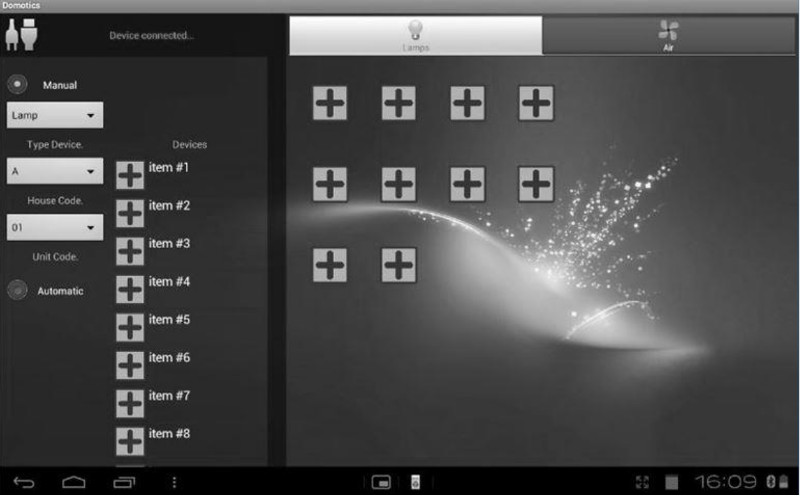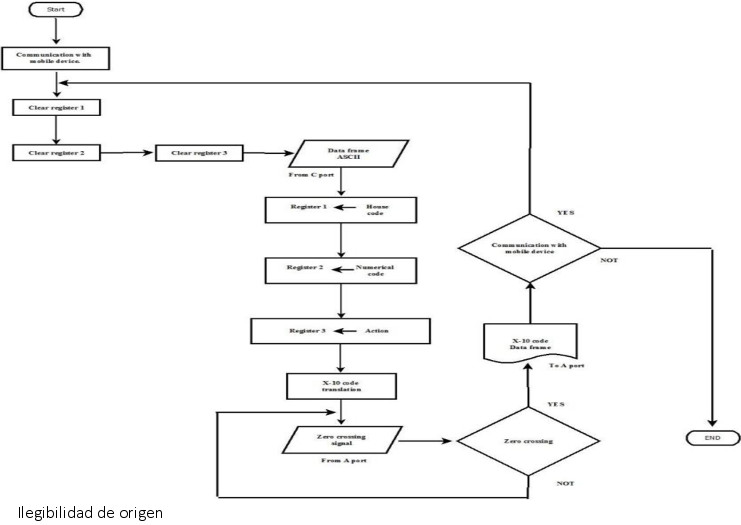1 Introduction
The evolution of housing development dates from the time when man became sedentary and left the caves. Currently, this development is focused on five main areas: security, culture, leisure and entertainment, comfort and energy savings, and economic activities and management1.
The term "home automation" is used to encompass all of these concepts, with the understanding that the set of habitat services supplied by systems that perform several functions, these systems are able to be interconnected with each other and/or to internal or external communication networks using the home computing application. The home automation also integrates the security systems set, and regulates housework activities, both aimed at supporting and facilitating daily living, by the automation of their functions and operations2. However, the penetration level of home automation concepts and their applications or functionalities has been very low, due to lack of knowledge about the possibilities of automation in the home, the low investment in research to generate our own technology and the associated installation costs. The result is costly devices that turn a house into a smart home, but not required for inhabitants3, there are a small number of specialized companies, mainly because of the incompatibility between sensors, processors and actuators1.
In view of the concepts presented above we propose a home automation prototype that integrates an existing technology that is easily accessible, promotes regular use and is cost effective.
On the other hand, according to the World Health Organization report (WHO) 4related to the aging of the world population between 2000 and 2050, the proportion of the world's population over 60 years old will double, from 11% to 22%, representing an increase from 605 to 2000 million seniors in the same period. More alarming is the number of seniors older than 80 years, which will quadruple in the aforementioned period, reaching a total of 400 million.
The same report mentions health problems affecting the elderly, highlighting chronic lung disease and arthritis among others. These diseases are disabling and hinder the mobility of people.
Likewise it is expected that by 2050 the number of elderly people who cannot fend for themselves, will quadruple in developing countries, which will make older people lose their ability to live independently due to their limited mobility, weakness or other health problems both physical and mental, and many will need long-term care, such as nursing and residential care.
Similarly it is proposed that environmental stimulants adapted to the needs of the elderly allow them a more fulfilled life as they increase their autonomy and active participation in society. Proposed strategies to improve the quality of life of this sector of the population include the creation of mechanisms to support the long-term care of those who suffer loss of functions. At the same time, with respect to persons with disabilities, the same WHO and the World Bank, in its World report on disabilities5 estimate that about 15% of the world populatiosufferrs from some form of disability, representing around 975 million individuals. People with severe disabilities make up 2.2% of the total population, ie 140 million, of which the majority are women and seniors.
The same report shows that this figure is increasing due to, among other factors, an aging population, environmental factors, traffic accidents, war, eating habits and substance abuse. Also is mentioned the fact that 30% of people with disabilities do not satisfy their needs for assistance related to performing daily activities and in the United States of America, 70% of people with disabilities rely on family and friends to provide them with assistance, reliance exclusively on informal support can have adverse consequences for caregivers, causing psychological and emotional stress, isolation and loss of socioeconomic opportunities.
In the same document, are shown proposals to governments to overcome disabling barriers among which are: lack of access to general services and lack of research and data collection and poor quality of life. Proposals to ease the transition to community life through support services and assistance for both the disabled and their informal caregivers can create favourable environments that remove barriers in public spaces, transport, information and communication, allowing people with disabilities to participate in education, employment and social life, reducing their isolation and dependence.
2 Current status of home automation
In the literature review we found a lot of definitions about home automation that have changed over time. According to3 home automation is the introduction of technology in the home in order to improve the different services offered like tele-health, comfort, multimedia entertainment and energy savings. In the same paper a home automation prototype is shown, where the home environmental conditions of a middle class home are controlled by different devices developed by the author, using solid state technology and communicated by ZigBee protocol.
In 2 we found a technical and accepted definition that defines home automation as a set of home services provided by systems that perform several functions and connect with other systems and/or internal or external communication networks. The main functions are: energy saving, technical management, information and communication, comfort control, security and assistance.
Moreover6 defines a smart home as a domestic environment where science is applied to improve thresidents'ts quality of life through flexible, comfortable and environmentally efficient solutions. The need to incorporate smart devices, like smart phones or tablets proposed in this prototype, focused on security, entertainment, comfort, communication and health care is expressed. Additionally a smart home control system is shown, based on information fusion, that allows access to the system using networks or internet to control the internal and external home services. These services are interconnected by Bluetooth and coordinated using fuzzy or neural networks, while7 defines a smart home as one that uses drivers to integrate several automation services.
Additionally8 performed a study of smart home applications focused othe carere of the elderly and proposed that modern houses that are equipped with smart home technology can help disabled people, not only to prevent social isolation, but also to provide assistance, without limiting the residents' daily routine. This provides comfort, relaxation and well-being, to promote handicapped or elderly independence, thereby reducing the caregivers workload9.
In this sense10 suggests the smart homes interdisciplinarity as a synergy between different knowledge areas such as architectu, computer science, electrical and electronics engineering, health and social sciences and the therapists and physicians involvement, for better interaction between people and their homes. Similarly11 defines a smart home as one which allows the automatic control over the devices installed inside the home, allowing energy saving, communication, security and comfort for home residents.
In12 a development based on Field Programmable Gate Array (FPGA) and a reprogrammable online device is shown. This development answers, at all times, to the user's needs, also proposes that a smart environment is one equipped with electronic systems able to adapt to the inhabitants' needs and/or preferences, in order to simplify their daily activities and add comfort.
Regarding the use of mobile devices to control the housing conditions13 uses a cell phone as an interface, and the KNX protocol for interacting with housing. This technology involves high costs, as it requires the installation of a bus communication that consists of a pair of wires, representing a major modification in housing, and the cost associated with sending SMS packages. Another disadvantage is the graphical user interface (GUI) because, a cell phone has a very small screen and the menus are based on hierarchies, hampering the understanding by users.
While14 developed a similar interface and uses the X-10 protocol for transmission to the system actuators, the system is based on data transmission by the WAP protocol (Wireless Applications Protocol) to a microcontroller, which acts like a translator between the information received via cell phone and sent, through the power line, using the X-10 protocol. Again a drawback is the type of menus that are used, hierarchical, and the system is subject to the data coverage of the telephone companies and their associated cost.
Other systems using mobile devices are designed for use from outside the house. In15 is proposed a system for remote home control, designed for people who are not usually in their homes. Its main objective is safety. The system is based on the implementation of SMS on a GSM network technology. It provides security systems in which an SMS is sent upon detection of an intruder and the user can send commands to activate certain appliances to simulate presence. In16 is shown a home automation system that uses the ZigBee protocol and a radio system for communication and control of the lights, off intrusion detection is shown, however the authors had to develop their own technology to develop the application.
The reported installation herein presents advantages over those shown in the literature review and because it employs a communication protocol that uses the electrical installation of a dwelling. It has a high level of security since the handling is only possible if the application is installed on the mobile device and the security code associated with the meta-developed interface is known. Another contribution to the low cost of the project is the use of free software for development. The mobile devices are used commonly and the metalanguage interface is simple to construct and program, also the GUI is friendly and easy to understand.
3 Developed architecture
The home automation architecture refers to the network structure understanding that it is a set of interconnected autonomous elements17. Figure 1, in block diagram form, shows the developed architecture for our home automation prototype, where it is possible to watch three basic elements: a Graphic User Interface (GUI) that allows the prototype and users interaction through fingerings on virtual switches and sends information integrated in a smart phone Bluetooth port; the second element is a metalanguage interface that is responsible for translating the received information from smart device, to X-10 code; and finally the actuators stage, formed by lighting, ventilation, heating elements and more.
In Figure 2 the network for developing home automation is shown. According to the network topologies shown in17 a bus type structure is used in this project with the aim of using the existing electrical wiring as a communication bus and the X-10 protocol, while the autonomous elements are represented for controlled plugs and switches.
18defines a communication bus as a physical path through which the information is sent from sender to receiver and could be guided or unguided. In our proposal, a guided bus is used, this bus is the electrical wiring installed inside the home with the following characteristics 120 Vac and 60 Hz, and represented by a horizontal line in Figure 2. Also18 defines a communication protocol as a standardized set of rules designed to allow the information flow between devices so that their representation, signaling, authentication and error detection is clearly defined and controlled. In a developed prototype we chose the X-10 protocol, because it allows the development of home automation applications without installation of new wiring in the home and using the power line carrier communications system.
In Figure 3 the detailed diagram of the home automation prototype is shown, starting in the GUI which was developed in a SONY tablet, model SGPT112MX/S with Android operative system 4.0.3 version. The metalanguage interface was formed by Bluetooth module, family 18's microcontroller, and PSC-05 X-10 module, and the actuators where controlled by different receptor modules of the X-10 family.
3.1 Graphical user interface (GUI)
In 19 a GUI is defined as an application, through which the user interacts with the system, and it is developed based on the best implementation of the user intelligibility. 20extends the GUI concept to integrate the perception concept, which is characterized by the integration of techniques that combine the natural human abilities to understand, communicate, move and cognitive and perceptual skills with input and output devices, machine perception and reasoning.
Focused on the above criteria and using Basic for Android software21,22 , the graphic user interface was designed and generated as shown in Figure 4, where it is possible to observe two main areas. The left side shows three drop down menus from which it is possible to select the type of device to be controlled and to assign the house and numerical codes mentioned in18. In this area is also shown a list of items to which, once the house and numerical codes were assigned, one can name the controlled devices. This name will be shown in both interface areas as Figure 5 shows. Users will touch the right area to control the state of system actuators.
Finally, Figure 6 shows the effect of touching any buttons on the right area. When a device is activated the button changes color to indicate the "ON" status, and returns to the original color when deactivated. At the same time this action triggers the sending of information via the Tablet's Bluetooth port, that in this case is an A2DP EDR Version 2. The information consists of three characters in ASCII code, which correspond to house code, the numerical code and the action. The last one is represented by a logical "1" to turn on and a "0" to disable. This information is received by Bluetooth module which is coupled with a microcontroller in a metalanguage interface whose function is described below.
3.2 Metalanguage interface
This interface is responsible for the information conversion from a mobile device, in ASCII code, for X-10 code, understandable for system actuators. Figure 7 shows the flow chart for the program contained in the microcontroller where the translation will take place.
The process starts when a mobile device is connected to the interface via Bluetooth port. Once established, the microcontroller registers 1, 2 and 3 are cleared and after that the data reception from smart device to metalanguage interface starts, storing: register 1: house code, register 2: numerical code and register 3: action code.
From the stored data, the X-10 code translation is performed. This translation was implemented using cases and pointers to microcontroller memory addresses that belong to each ASCII code element stored in other registers.
After translation, a sync pulse is expected from X-10 PSC05 module. Based on this pulse all the X-10 data frame is submitted through the existing electrical wiring and this action activates or deactivates the controlled devices. Finally if the smart device to metalanguage interface communication lingers, the process could continue, otherwise the program execution ends.
3.3 Bus and communication protocol
As mentioned throughout this paper, the X-10 was selected as the communication protocol due to the advantages shown in 18, including, the use of electrical wiring as a communication bus making it unnecessary to install new wires inside the house, the Plug & Play function that makes it easier to install new equipment, the number of controlled devices (256) enough for a middle class home, the effective appropriate operation distance, and the power stage included in X-10 devices.
4 Results
A controlled domotic installation by mobile devices was implemented, facilitating the control of environmental conditions, by people with motor disabilities. The home automation system was developed based on technology availability and low cost.
The communication bus and selected protocol are an advantage compared to other buses as they allow communication to control devices without the need to do modifications to the houses. Although the communication distance using the Bluetooth protocol is limited, this situation is easily solved by installing repeaters, while the distance to the X-10 protocol poses no problem since the information is lost until it finds an electric transformer in the line.
Installation tests have been carried out, grouped into two parts. The first group is related to the effective distance between the mobile device and the metalanguage interface, where the line of sight reaches 15 m, with obstacles represented by walls or slabs of housing, distance is affected, reaching maximum 10 m, enough to cover the needs of a regular size home.
The second group of tests relates to the effectiveness of the X-10 protocol, for which a sample of 116 addresses was selected, representing a confidence level of 90% and a margin of error of 5%.
In this domotic system the following appliances were connected: LED screen, incandescent bulbs, fluorescent lamps, a microwave oven, a hair dryer and iron, a blender, a fan and an electric oven. They were activated and deactivated at 116 previously selected addresses, including the assigned addresses to each of the above appliances, getting a 98% effective rate. A failure occurred when inductive loads were overloaded i.e. when the blender had a large mechanical load and the engine was forced to operate, however with other devices no errors were observed in the system. The results of these tests are shown in Table 1.
5 Conclusions
Unlike other home automation applications reported in the literature review, this home automation system uses an inexpensive technology accessible to the general population. It does not require the installation of new infrastructure in the home, and does not depend on the reliability of wireless systems such as Zig-Bee, or Wi-Fi that are very sensitive to electromagnetic disturbances such as those caused by fluorescent lamps or inductive loads such as electric motors.
By using Plug & Play technology, the scalability is simple and does not require an expert to carry it out, likewise, adding new devices to the interface only requires assigning the address and the name, which likewise does not require experts.
The use of elements of the X-10 family allows them to be employed, as a controlled device or a regular device. This situation works as a security support in case of a fault in the system.
With the results both, for the communication distance between metalanguage interface and the mobile, and to test the effectiveness of the X-10 protocol, it is observed that the reliability of the developed system is high enough to be installed in homes inhabited by disabled and elderly people, allowing for increased comfort and independence within their homes and improved a quality of life.











 nueva página del texto (beta)
nueva página del texto (beta)









